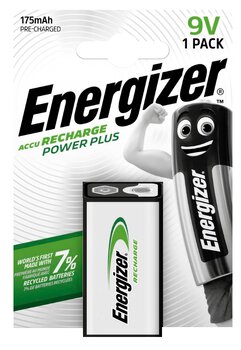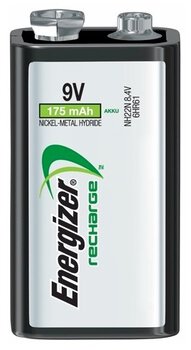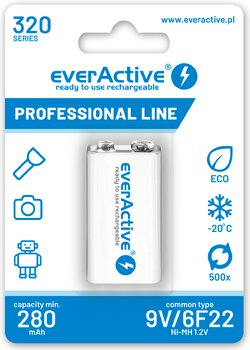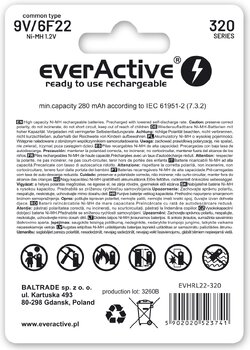- Tips
- technology
- Frequently Asked Questions
- Tests
- mAh capacity
- Rated Capacity
- everActive
- comparison
- Durability of rechargeable batteries
- Efficiency of rechargeable batteries
- battery voltage
- Accumulated energy
- Batteries vs rechargeable batteries
- LR03 AAA
- LR6 AA
- eneloop
- AG13 LR1154 LR44
- Delta V
- Charge Cycles
- internal resistance
- charge level
- CR 2032
- memory effect
- accredited test
- SR44 357
- Hearing Batteries 675
- SR626 377
- Watch Batteries
- Polarity
- Mah
- passivation
- LS 14250
- LS 14500
Great 9V battery test, technology comparison: alkaline vs Ni-MH vs Li-ion, which is the best?
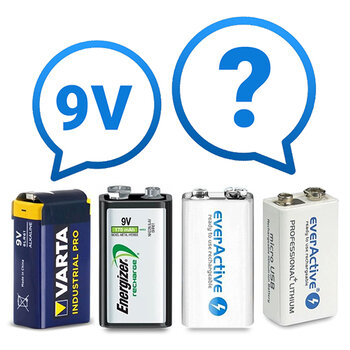
Product presentation, test purpose
For testing, we have chosen well-known, proven and valued for their quality 9V rechargeable batteries and batteries. They were made in various technologies. We hope that the results will allow you to choose the right solution for your device.
Which battery, with what chemistry lasts the longest? Which one gives off the most energy? Does an alkaline battery offer a higher voltage than rechargeable batteries? You will find the answer to all this in our test.
1. Varta Industrial Pro Alkaline 9V 6LR61 Battery
Manufacturer's data:
- Chemistry: Zn-MnO2 (Alkaline)
- nominal voltage: 9V
- capacity: 640 mAh (620 Ohm load to 5.4V)
- Energy: 4915 mWh (620 Ohm load to 5.4V)
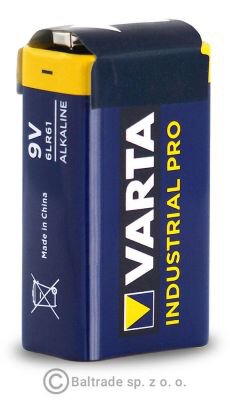
2. Energizer Ni-MH 8.4V battery
Manufacturer's data:
- Chemistry: Ni-MH (Nickel-Metal Hydride)
- nominal voltage: 8.4V
- capacity: 175 mAh (35 mA to 7V load)
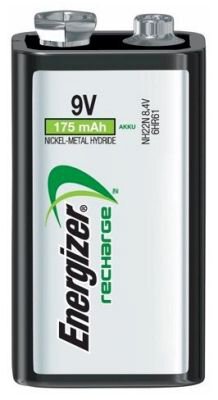
3. everActive Professional Line Ni-MH 8.4V battery
Manufacturer's data:
- Chemistry: Ni-MH (Nickel-Metal Hydride)
- nominal voltage: 8.4V
- capacity: 280 mAh (56 mA to 7V load)
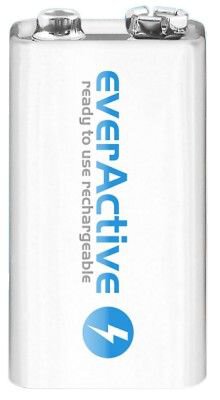
4. everActive Professional+ Lithium Li-ion 7.4V battery
Manufacturer's data:
- Chemistry: Li-ion (lithium-ion)
- nominal voltage: 7.4V
- capacity: 500 mAh (100 mA to 6V load)
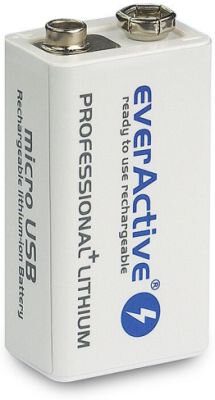
Comparing the raw technical data, you can get the impression that an alkaline battery is superior to rechargeable batteries with a higher capacity and a higher nominal voltage, so it should last the longest/most reliably - are you sure?
Test Procedure
We used 4 pcs for testing. of alkaline batteries and one of each rechargeable battery. The batteries before the tests were formed by 3 times full charge and discharge.
The tests consisted of discharging at room temperature with currents: 50 mA, 100 mA, 200 mA and 500 mA. The measurement uncertainty in our test was 2%.
On the basis of the recorded measurements, the capacity [mAh], energy [mWh], internal resistance [mOhm] of all cells were calculated.
As the total discharge threshold we set the value of 4V - this is the limit voltage at which many multimeters refuse to work, etc.
Test No. 1 - 50 mA discharge
A current of 50 mA is a moderate value for a 9V size battery. Many devices in an impulse require higher values, but in many applications (most electronic multimeters) the need is much smaller. We decided that this was a good starting point for further more demanding tests.
To start with, the bare results - we remind you that the limit discharge threshold was reaching a voltage of 4.0V.
Capacity:
1. Alkaline Battery: 598mAh
2. Li-ion battery: 530mAh
3. Rechargeable Ni-MH 280: 316mAh
4. Rechargeable Ni-MH 175: 196mAh
Energy:
1. Alkaline battery: 4331mWh
2. Li-ion battery: 3946mWh
3. Rechargeable Ni-MH 280: 2731mWh
4. Rechargeable Ni-MH 175: 1719mWh
Note that although the alkaline battery definitely wins in the capacity test, it is not so convincing when we take into account the accumulated mWh energy.
The mAh capacity is a unit that should only be compared for cells with exactly the same output voltage, made in the same technology - its value is not affected by the battery voltage during operation. The actual battery performance is much more accurately determined by the energy expressed in mWh - its value takes into account the output voltage of a given battery during operation.
Medium Voltage:
1. Rechargeable Ni-MH 175 battery: 8.75V
2. Rechargeable Ni-MH 280: 8.64V
3. Li-ion battery: 7.43V
4. Alkaline battery: 7.24V
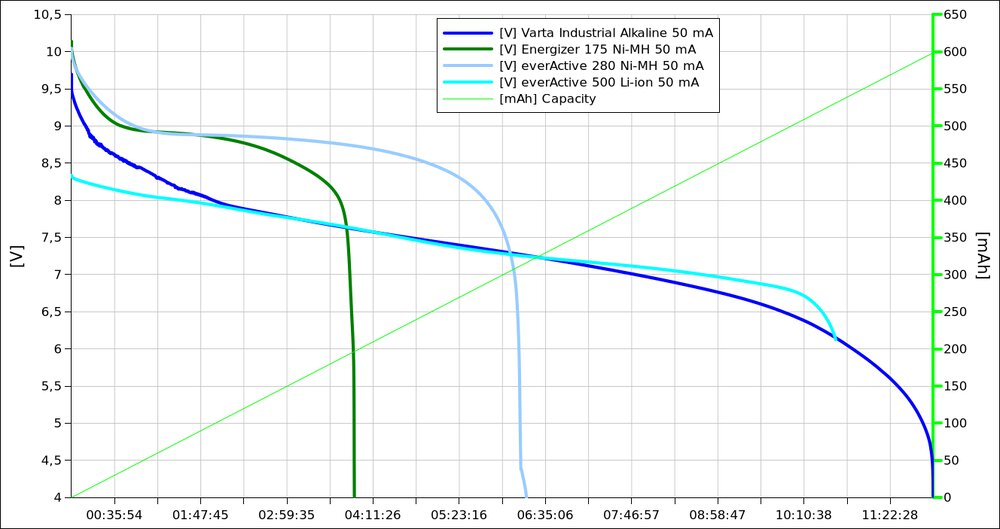
It turns out that the alkaline battery with the highest declared nominal voltage of 9V actually offers a similar output voltage to a Li-ion 7.4V battery.
8.4V Ni-MH rechargeable batteries offer by far the highest output voltage.
Ultimately, in the conditions of 50mA discharge, up to the level of 4.0V, the alkaline battery wins, but if our device required a voltage above 7.0V to work, the alkaline battery would lose to the Li-ion battery, only slightly winning with the Ni-MH 280 battery. Below are graphs presenting the dependence of the achieved values of capacitance and energy on voltage.
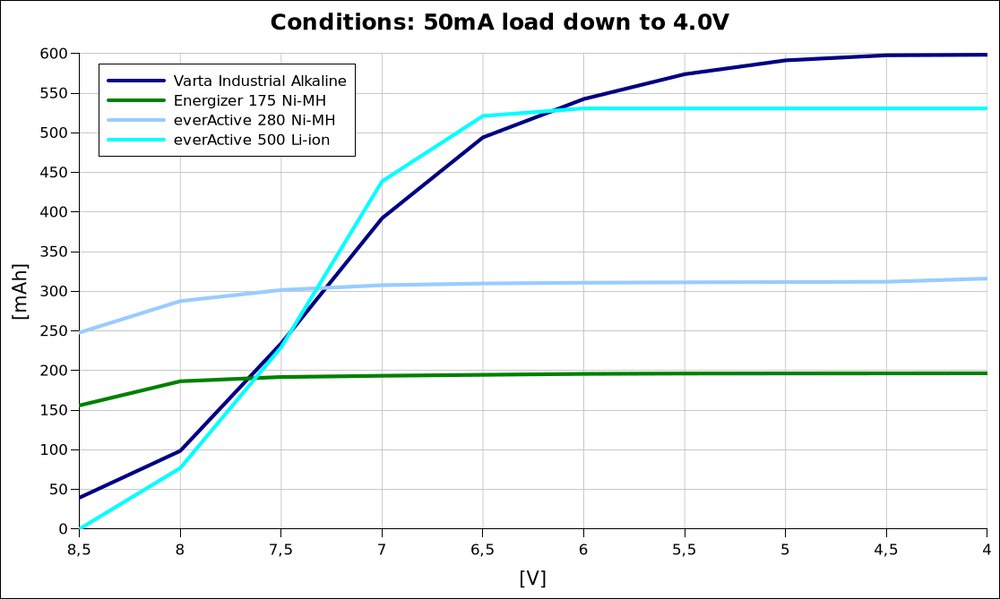
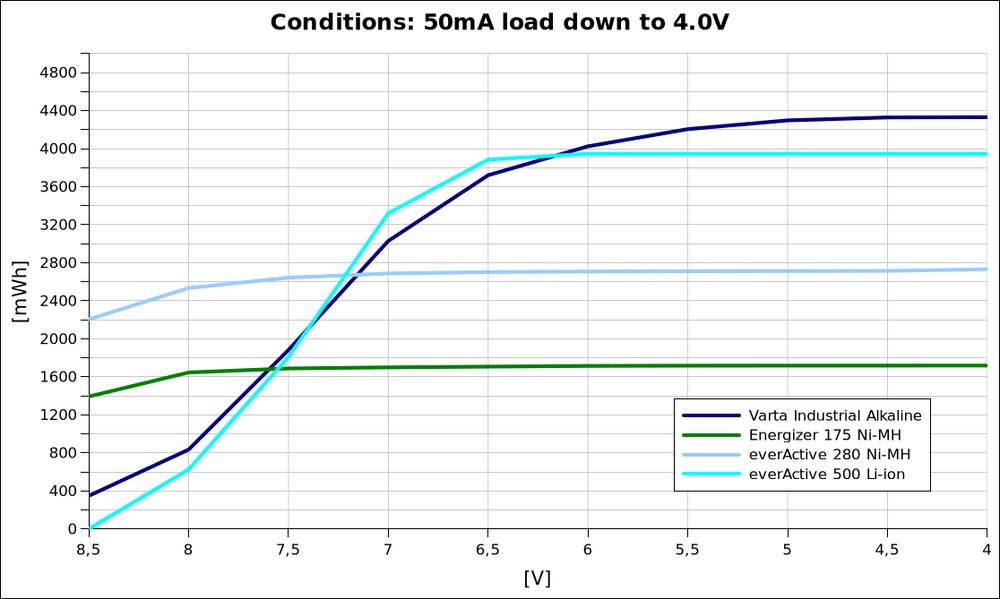
PS. The inquisitive will point out that the alkaline battery is the only one that did not reach its declared capacity in this test - this is due to the fact that the discharge current of 50 mA is still too high to meet this condition. The Varta alkaline battery reaches its declared capacity under a load of 620 Ohms, which can be compared to a discharge current of about 10 mA. The higher the load, the usable capacity of the alkaline battery clearly decreases - this will be shown by subsequent tests.
Test No. 2 - 100 mA discharge
A discharge current of 100 mA is still quite moderate when it comes to 9V batteries. Such consumption is characteristic of some non-contact thermometers, some toys, etc.
Capacity:
1. Alkaline Battery: 538mAh
2. Li-ion battery: 528mAh
3. Rechargeable Ni-MH 280: 293mAh
4. Rechargeable Ni-MH 175: 186mAh
Energy:
1. Li-ion battery: 3912mWh
2. Alkaline Battery: 3782mWh
3. Rechargeable Ni-MH 280: 2508mWh
4. Rechargeable Ni-MH 175: 1601mWh
Medium Voltage:
1. Rechargeable Ni-MH 175 battery: 8.59V
2. Rechargeable Ni-MH 280: 8.56V
3. Li-ion battery: 7.40V
4. Alkaline battery: 7.03V
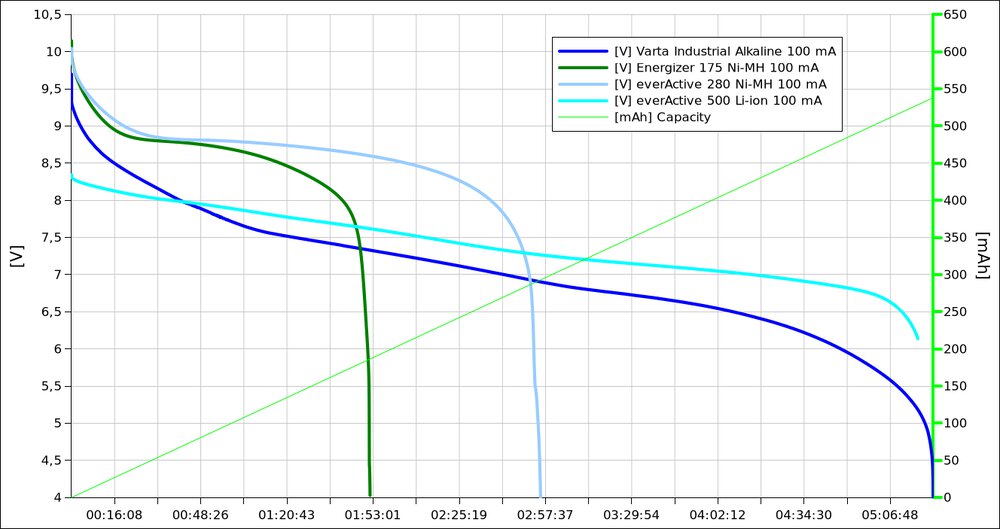
A load of 100 mA means a significant decrease in the capacity achieved by alkaline batteries and an even greater loss in the stored energy. All batteries, on the other hand, offer very stable parameters, similar to those at 50 mA.
It is difficult to consider an alkaline battery as a winner in 100 mA discharge conditions.
When discharged to 7.0V, the alkaline battery clearly loses even with a 280 mAh Ni-MH battery (due to the lower power output).
Below are graphs presenting the dependence of the achieved values of capacitance and energy on voltage.
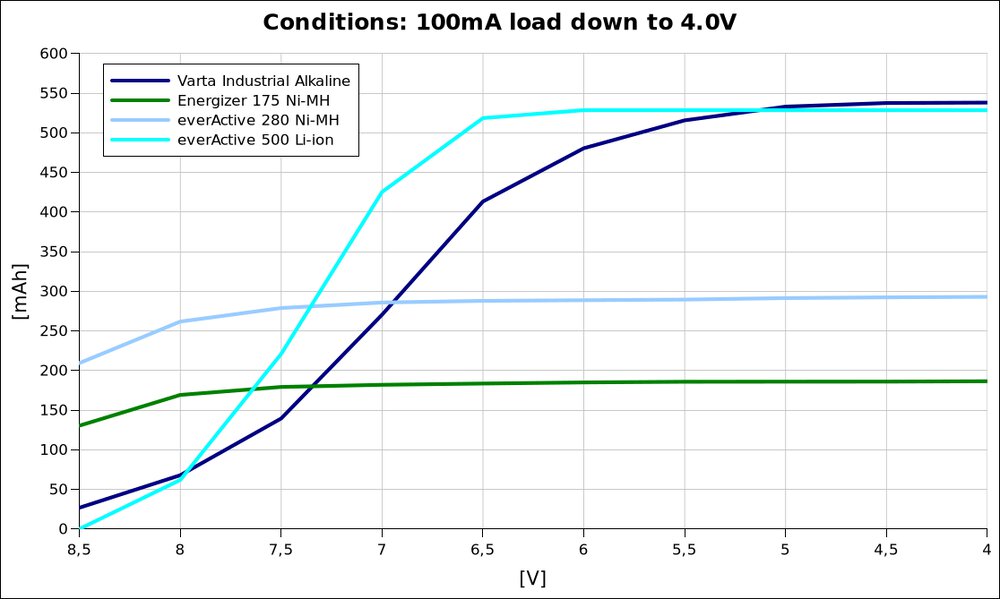
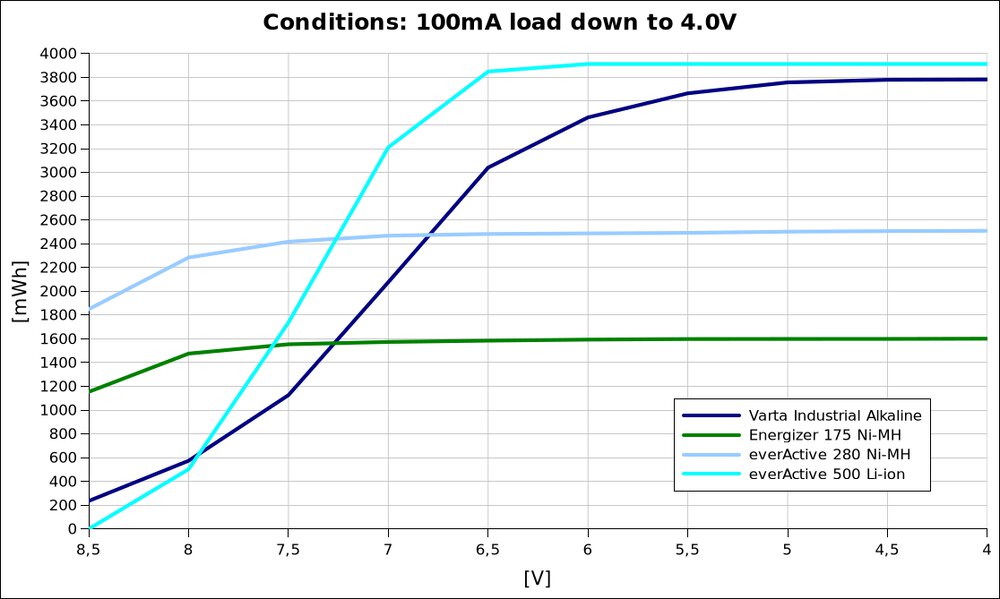
Test No. 3 - 200 mA discharge
A discharge current of 200 mA is already quite demanding conditions for a 9V battery. However, there are still devices in use that have even higher temporary energy requirements - e.g. paintball accessories, etc.
Capacity:
1. Li-ion battery: 526mAh
2. Alkaline battery: 465mAh
3. Rechargeable Ni-MH 280: 288mAh
4. Rechargeable Ni-MH 175: 186mAh
Energy:
1. Li-ion battery: 3854mWh
2. Alkaline Battery: 3158mWh
3. Rechargeable Ni-MH 280: 2399mWh
4. Rechargeable Ni-MH 175: 1543mWh
Medium Voltage:
1. Rechargeable Ni-MH 280: 8.34V
2. Rechargeable Ni-MH 175 battery: 8.30V
3. Li-ion battery: 7.33V
4. Alkaline battery: 6.75V
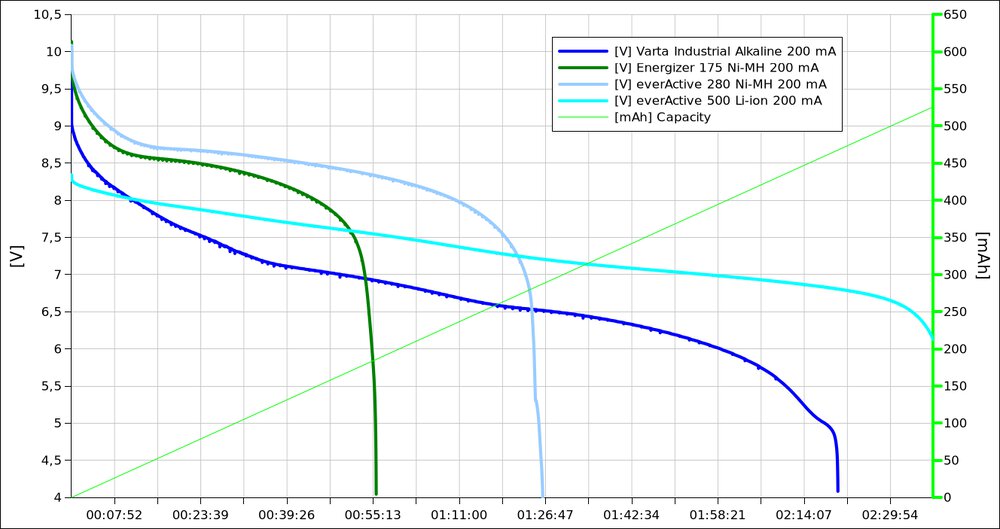
A 200 mA load is a further decrease in capacity and accumulated energy in an alkaline battery. All batteries are still very stable. It is worth noting that Ni-MH batteries have clearly the highest output voltage in the entire field.
Below are graphs presenting the dependence of the achieved values of capacitance and energy on voltage.
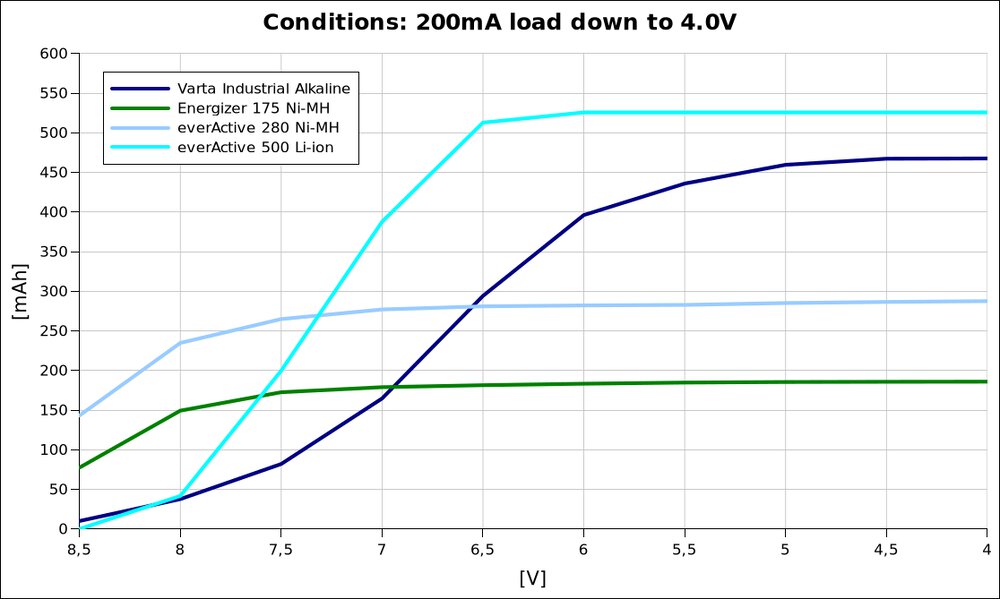
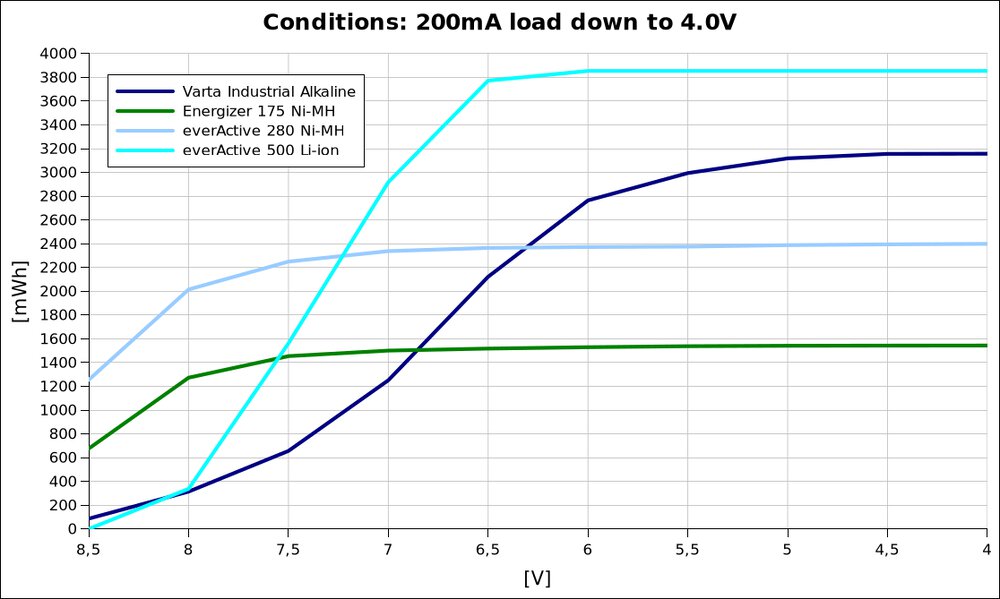
The winner under 200 mA discharge conditions is the everActive Li-ion battery.
When discharged to 7.0V, the alkaline battery loses even to the least capacious 175 mAh Ni-MH battery.
Test No. 4 - 500 mA current discharge
A discharge current of 500 mA is a rare load value in typical applications. However, the test shows what users can expect in the most energy-demanding devices.
Capacity:
1. Li-ion battery: 507mAh
2. Alkaline battery: 378mAh
3. Rechargeable Ni-MH 280: 278mAh
4. Rechargeable Ni-MH 175: 182mAh
Energy:
1. Li-ion battery: 3626mWh
2. Alkaline battery: 2326mWh
3. Rechargeable Ni-MH 280: 2185mWh
4. Rechargeable Ni-MH 175: 1417mWh
Medium Voltage:
1. Rechargeable Ni-MH 280: 7.87V
2. Rechargeable Ni-MH 175 battery: 7.79V
3. Li-ion battery: 7.15V
4. Alkaline battery: 6.15V
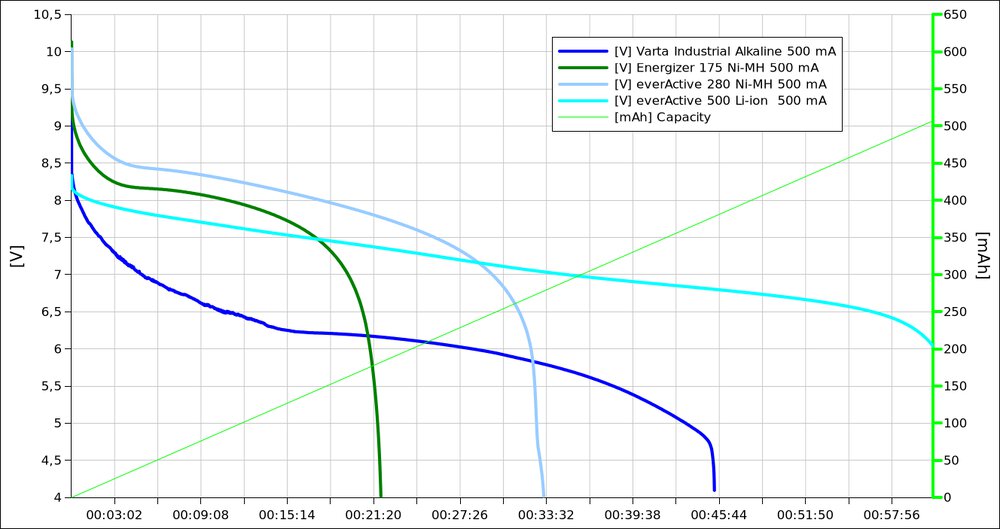
A load of 500 mA is clearly too much for a typical alkaline battery. All batteries remain very stable.
Below are graphs presenting the dependence of the achieved values of capacitance and energy on voltage.
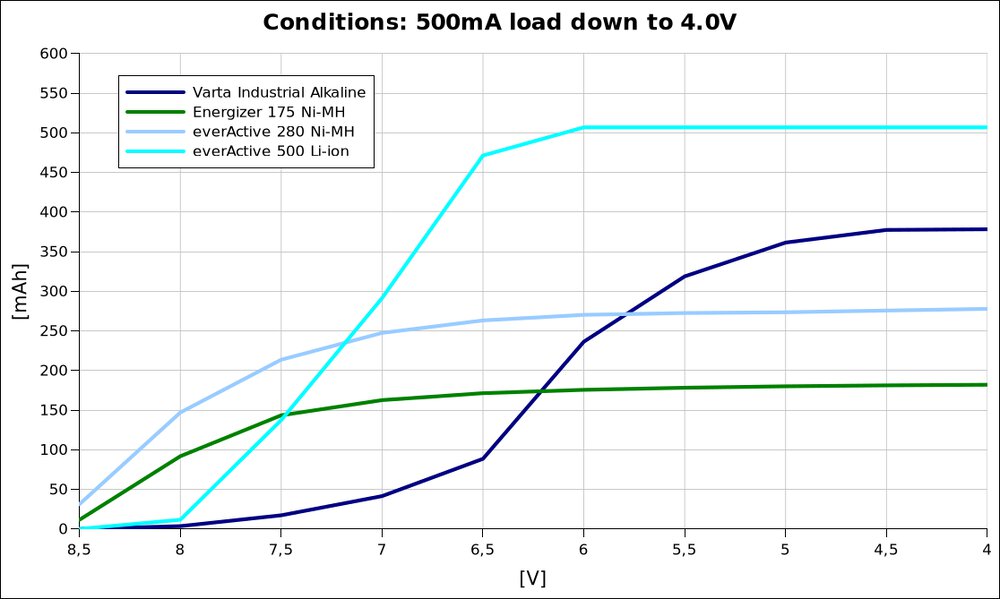
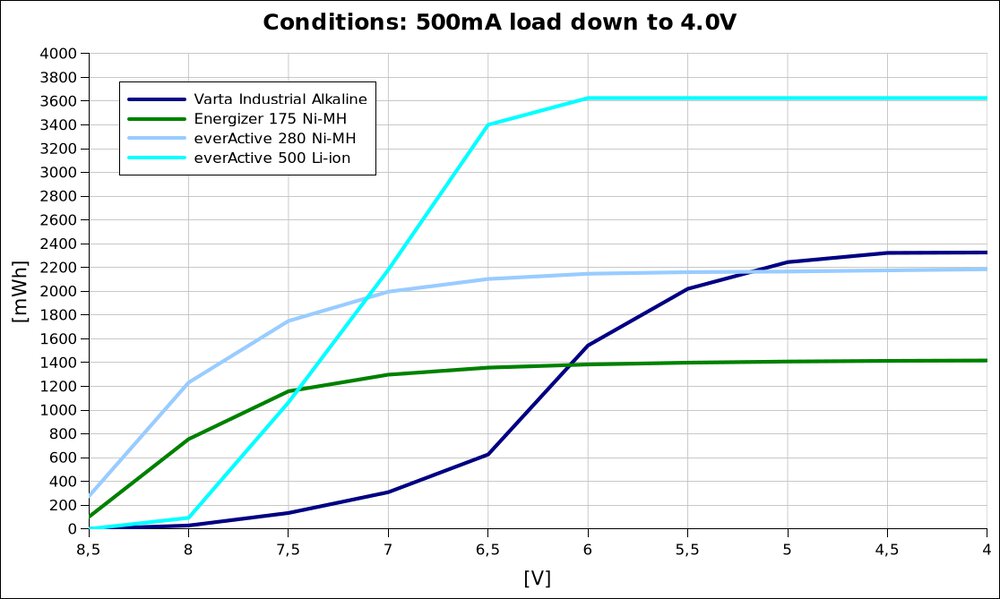
The winner in 500 mA discharge conditions remains the everActive Li-ion battery.
An alkaline battery in a utility test, when discharged to 7.0V, would be clearly the worst.
Test and Results of Internal Resistance Measurement
Less=Better
The lower the resistance, the lower the voltage drop on the battery during operation, which translates into higher current efficiency (higher power output).
Results:
1. Li-ion battery: 0.3 Ohm
2. Rechargeable Ni-MH 280 battery: 0.87 ohms
3. Rechargeable Ni-MH 175 battery: 1.48 ohms
4. Alkaline battery: 2.03 Ohm
By far the worst result of the alkaline battery was predictable based on previous performance tests.
The clear winner - the Li-ion battery.
Why such a difference in operating voltage between Ni-MH batteries and other cells of the same size?
The alkaline battery, despite its nominal voltage of 9V, offers the lowest output voltage levels in the entire test.
Why?
- For alkaline batteries, the nominal voltage is the start voltage of a brand new battery, while for rechargeable batteries it is the average voltage during operation. We wrote about it in the article: Differences between alkaline batteries and Ni-MH rechargeable batteries.
- In the case of a 9V battery, the difference is also due to the design of the battery itself. A typical single 1.2V Ni-MH battery has a similar operating voltage as a 1.5V alkaline battery. On the other hand, one typical 3.7 V Li-ion battery has a similar operating voltage as 3 Ni-MH batteries connected in series or 3 1.5V alkaline batteries.
In a 9V alkaline battery, we have 6 1.5V cells connected in series, resulting in a voltage of 9V. In Ni-MH batteries, we usually have one more cell - 7 1.2V cells give a voltage of 8.4V - in practice, such a battery would correspond to an alkaline battery with a nominal voltage of 10-10.5V.
A 9V Li-ion battery, on the other hand, consists of two 3.7V cells connected in series - this corresponds to 6 1.5V alkaline cells - which is why the Li-ion battery has the most similar characteristics to a disposable battery.
Test winner
The undisputed winner of the entire test, taking into account all partial results, is the everActive Professional+ Lithium Li-ion battery with a capacity of 500 mAh.
It provides the highest compatibility and compatibility with a disposable alkaline battery while offering consistent, ultra-long runtimes regardless of the application. Maintains stable, high voltage even under high loads. It has the lowest internal resistance of any battery tested.
The downside is the relatively high cost of purchase. Remember, however, that in addition to the very high capacity, this battery has an integrated charger - a micro USB connector (it does not require the purchase of a dedicated battery charger). This battery is the only one in this list that also has electronic protection against extreme discharge, overcharging, as well as short circuit.
Who are the other 9V batteries and alkaline batteries for?
Ni-MH batteries, due to their higher output voltage, work very well in devices that require increased voltage to work. Their low internal resistance gives them an advantage over alkaline batteries also in devices with high current consumption.
Alkaline batteries work best with undemanding devices - especially where they last several months between replacements.
Author: Michał Seredziński
Copying the content of the article or its part without the consent of a representative of Baltrade sp. z o.o. is prohibited.
Tested batteries and accumulators available in hurt.com.pl
everActive 6F22/9V Ni-MH 320 mAh ready to use "Professional line"
-
Bardzo fajna analiza porównawcza ale mnie ciekawi skąd biorą się pojemności rzędu 10-12 tyś mAh tych ogniw oferowanych w internecie np. Aliekspress czy Allegro. Chciałbym kupić dobre akumulatorki ale nie wiem gdzie i czym się kierować. Producenci piszą na swoich wyrobach totalne bzdury. To już nie jest chwyt marketingowy a przestępstwwo. Dotyczy to również innych popularnych akumulatorków jak R3 czy R6. Może ktoś odważy się i piwie gdzie kupić dobre akumulatorki które będą miały realne parametry.
-
Na rynku można znaleźć różne akumulatorki najczęściej chińskich marek, pod którymi nie podpisuje się żadna godna zaufania firma/importer.
Producenci, importerzy sprowadzający akumulatorki do EU są zobligowani do spełnienia konkretnych wymagań dot. ich pojemności - pojemności muszą być podane zgodnie z międzynarodowymi normami PN/EN/IEC. Tak stanowi prawo, niestety nie jest przez wszystkich respektowane.
Każdy akumulator AAA z deklaracją pojemności powyżej 1100 mAh, AA powyżej 2700 mAh, czy 18650 powyżej 3500 mAh to na dzień dzisiejszy potencjalne, bardzo prawdopodobne oszustwo.
Gdzie kupić tylko sprawdzone pewne akumulatorki? Oczywiście na hurt.com.pl. Firma Baltrade, właściciel serwisu od ponad 30 lat specjalizuje się w dystrybucji sprawdzonych źródeł zasilania.
-
-
Właśnie takich informacji szukałem w sieci. Byłem ciekawy jak sprawują się akumulatorki w porównaniu do baterii alkalicznej. Zastanawiałem się czy multimetry zasilane właśnie bateriami 9V będą prawidłowo działały na akumulatorach Li-ion, bo obawiałem się zbyt niskiego napięcia. Teraz już wiem, że bezpodstawnie i śmiało można je zamienić.
Li-ion ma niezaprzeczalną zaletę, że nie potrzebuję dodatkowej ładowarki do Ni-MH 9V ;)
